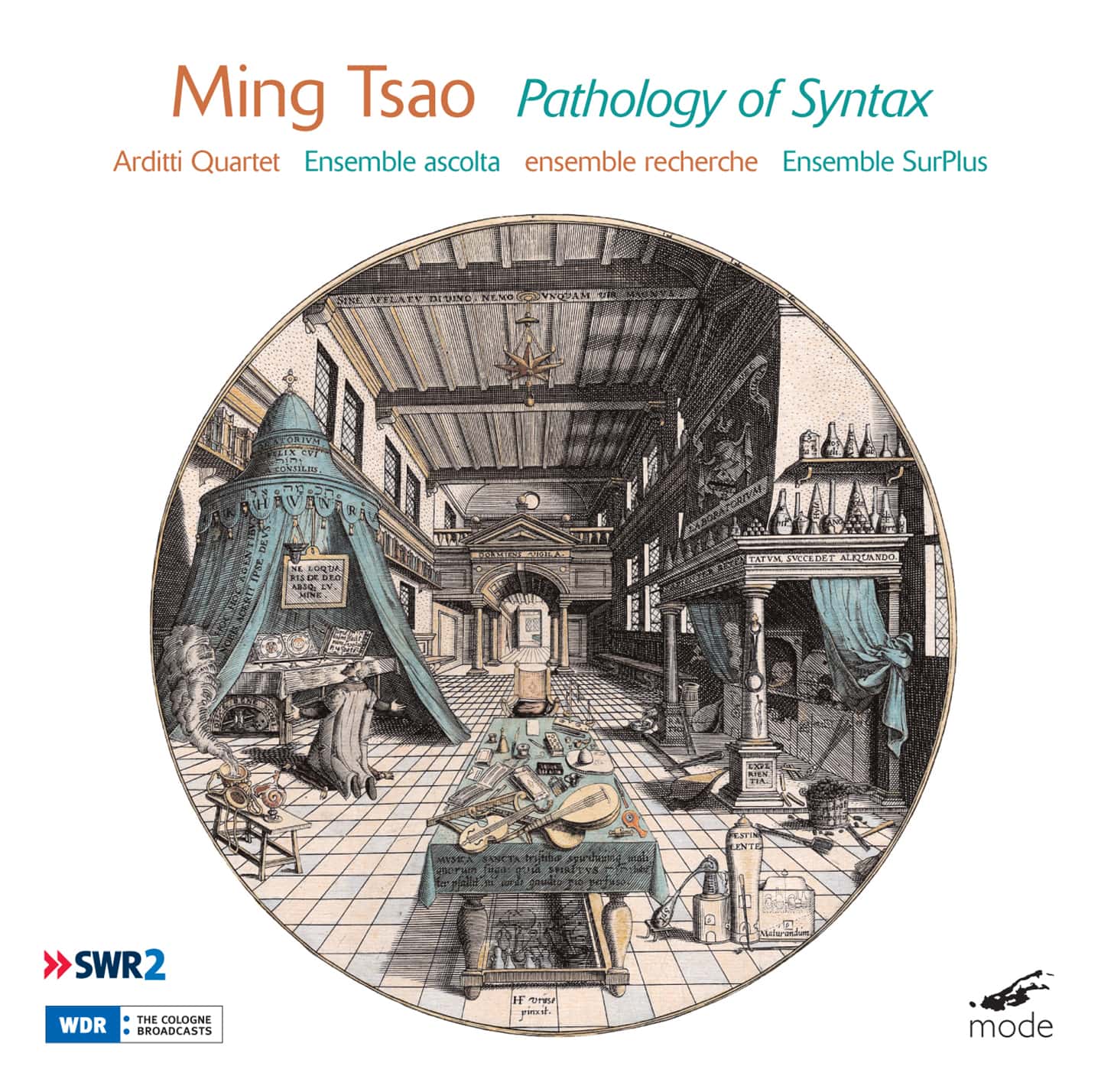Pathology of Syntax
1. Pathology of Syntax (2006–07) 15:53
for string quartet
The Arditti Quartet
2. (Un)cover (2008)
for trumpet, trombone, piano, guitar, cello & percussion
Ensemble ascolta
Jonathan Stockhammer, conductor
3. The Book of Virtual Transcriptions (2004-05)
for oboe, trumpet, horn, trombone, violin, viola & cello
Ensemble SurPlus
James Avery, conductor
4. Not Reconciled (2002-03)
for clarinet, trombone, guitar, cello & percussion
Ensemble SurPlus
Jonathan Stockhammer, conductor
5. One-Way Street (2006)
for clarinet, oboe, violin, viola, cello & percussion
ensemble recherche
6. Canon (2001)
Anthony Burr, clarinet. Charles Curtis, cello
Ming Tsao is a Chinese-American composer active in Europe. His works have been performed at the Donaueschingen Festival, Wien Modern, Wittener Tage, Maerz Musik and Darmstadt. Tsao’s composition teachers include Chaya Czernowin, Brian Ferneyhough and Mario Davidovsky. Tsao is also Professor of Composition at Göteborg University, Sweden. He holds composition degrees from University of California, San Diego and Berklee College of Music.
This is the first monographic CD of Tsao’s music.
Pathology of Syntax attempts to simulate a late Beethoven quartet. The Beethoven fragments dissolve into the physicality of the string quartet medium where the energy of bowing, plucking, scraping and brushing physical materials such as hair, wood and metal achieves an independence from the transcribed material it seeks to represent.
One-Way Street is a meditative, contemplative work that gradually disassembles what we assume to be beautiful: natural harmonics, drones and ecstatic rhythms.
In Not Reconciled, the sound of fingernails brushing against strings, the rattling of snares on a snare drum or the clicking of clarinet keys settle into a sound world tentatively held together by the incongruous instruments that create it.
(Un)cover is a meditation on the opening of Beethoven’s last piano sonata, opus 111 (first movement).
The Book of Virtual Transcriptions consists of 49 aural signs ranging from abstract to concrete images of musical material from the Adagio movement of Mozart’s oboe quartet (K.V. 370). These signs and their relations pose as stimuli that force the brain to complete a virtual transcription of the Mozart movement in which one constructs a way to listen to the Mozart that engages the musical unconscious.
Canon probes the limits of a musical canon through references to Bach’s Musical Offering.
Liner notes by Steven Kazuo Takasugi.
Reviews
Musikalisch weitaus fragiler, philosophisch zudem widersprüchlicher arbeitet Ming Tsao. 1966 geboren in Berkeley, Kalifornien, erlernte der chinesisch-amerikanische Komponist früh das Spiel von Violine und Bratsche, dann aber auch die chinesische Griffbrettzither Quin. Er studierte Ethnomusikologie, ebenso elektronische Komposition. Dieser geradezu bi-polare Spagat in seiner Jugend mag heute die Basis sein für ein Komponieren, das sich jenseits konven-tioneller musikalischer Formen und Klänge bewegt.
Sehr treffend Pathology of Syntax ist Tsao‘s neue, bei Mode Records in New York erschienene Platte betitelt, die sechs Ensemblekompositionen jünge-ren Datums enthält. Das Gemeinsame an ihnen ist, dass sie allesamt Spannungs-gefüge zwischen Geräuschen und Klängen darstellen und ausloten. Ming Tsao untersucht komponierend Mikrostrukturen musikalischen Vokabulars und stößt auf Rätselhaftes, Instabiles, permanent Veränderliches. Was eigenschöpferisch dabei entsteht, wirkt seinerseits grenzwertig, offen – derweil Tsao sich gera-dezu dekonstruktivistisch auf die Meister der europäischen Klassik beruft. In The Book of Virtual Transcriptions zum Beispiel wähnt sich der Komponist von Mozarts Oboenquartett inspiriert, derweil er den Bläsern gedämpfte, verstimmte Klänge vorschreibt. (Un)cover nimmt umgekehrt Bezug auf Beethovens Opus 111, vermittelt indes ein rastlos nervöses Warten auf etwas. One-Way-Street, ein zweifellos leichter erschließbares Stück, reiht kaleidoskopisch verschiedene instrumentale Artikulationen; man kann sie als Imitate verschiedener musika-lischer Sphären verstehen und hört so z.B. die chinesische Zither, dann amerika-nische Straßenmusik. Zuletzt mündet die Einbahnstraße beredt in eine globali-sierte Maschinenmusik.
(plays “One Way Street”)
One Way Street – hier dargeboten vom Freiburger ensemble recherche. Diese und fünf weitere Ensemblekompositionen des Amerikaners Ming Tsao finden sich auf einer bei Mode Records editierten CD, die sich aus Aufnahmen mit verschiedenen süddeutschen Formationen wie zum Beispiel Surplus, ascolta oder eben recherche rekrutiert. Neue Musik als Kunst … – ein Hineinhören lohnt!
Was ist asiatische neue Musik? Wie klingt sie, was macht sie aus? Ist das Be-sondere an ihr eine exotische Prise Folklore, die Beigabe von Tradition? Gibt gibt es einen eigenständigen Beitrag Ostasiens zur Avantgardemusik?
— Frank Kämpfer, as part of a feature on Asian composers on “Die neue Platte: Neue Musik” program, Deutschlandfunk radio, Sonntag, 6.7.2014
Links
Ming TSAO Profile
Arditti Quartet Profile
ensemble recherche Profile

